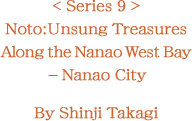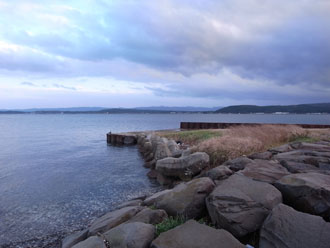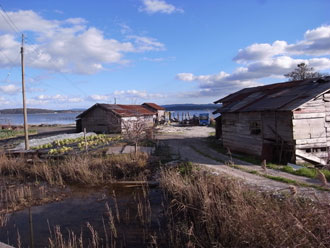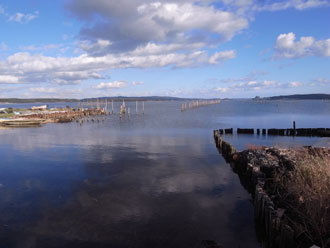

|
 |
In a series of ten articles under the heading of Noto: Unsung Treasures, the architect Shinji Takagi, who was born and raised in Wajima in Ishikawa prefecture, seeks to identify some of the interesting buildings and their background, old local customs and various pieces of engaging landscape, all of which might not make it into a tourist guide but are nevertheless of considerable interest. Leaving Wakura Spa and heading off into the heartland of the Noto Peninsula, we have a choice of routes. If we ignore Route 249 and the Noto Satoyama Coast Road, we can then follow a road skirting the sea as soon as we leave the western perimeter of this hot-spring resort. The road follows the edge of Nanao Nishi-wan, the west bay seen to our right along with views of Noto Island visible across the water. There is little traffic along this bay-hugging road, which seems to be largely forgotten. Noto Island sits comfortably in the waters of the bay with something special to offer at any season. And, in contrast to the rough and rugged seascape of the western Sotoura coast of the peninsula, the scene here is one of peace and tranquility. Here and there out in the water are signs of oyster farming―buoys and bamboo stakes marking the extent of the farming. The seemingly random arrangement of bamboo stakes projecting from the gently rippling waters creates an ensemble of stillness and beauty to delight the eye. This, however, is not always the case. The air of tranquility is sometimes broken by storms. This unsettled atmosphere is compounded by the oyster farmer's boats and the rundown state of the small huts where the oysters were shelled. All was well here once upon a time but now some disarray ensues. Weather boarding and fittings are now missing from some of the huts and the sea beyond sparkles behind them with an inevitable beauty that only nature can provide. This is without a doubt a favorite spot of mine. |
 


|
Having first passed Nojima Park and then after crossing Heisei Bridge as we continue north in the direction of Anamizu, we come to Shiotsu in Nakajima. Following the route around the bay to our right we pass by the now disused Shiotsu swimming beach. From here there are distant views of Wakura Spa on the opposite shore of the bay. At the end of a small promontory there is an unspoiled natural forest known as Karashima no Mori in which there are Tabu trees (Machilus thunbergii) and wisteria. Facing the sea here is the Karashima Shrine. On the fourth Saturday of July the shrine hosts a summer festival―Kagaribi Koi Matsuri. A portable shrine and illuminated tower-like floats called kiriko are taken from the shrine, placed on boats along with other portable shrines and floats from the mountains to encircle kagaribi―fire baskets, around which the boats then parade. This scene then develops into a real spectacle. In the evening light, the boats are joined by some 3,000 floating votive lantern-like offerings―oil soaked wood shavings are placed on lotus leafs and lit. The light from these and the kiriko towers reflect on the surface of the sea to produce a scene of sheer beauty. As a child living in Wajima, we amused ourselves in various ways. There were few cars on the roads then and they were therefore somewhere us kids liked to play. Putting on homemade bamboo skates, I remember how we used to skate on the snow-packed and icy roads until late in the evening. Back in the house we sat with our legs tucked under the warming kotatsu―a low table with a padded drape on a frame under which was an infra-red lamp. Here we enjoyed the sweetened bean jelly called yokan. Otherwise we sat peeling Satsumas and threading them onto a string. Then holding the string we ate the juicy fruit. Simple pleasures but fun to us. It was back then in the winter that a man wearing a black army-issue coat would come round with large buckets suspended from a yoke. He went on his rounds in Wajima selling oysters, crying out in a rather plaintive, shrill voice, “Nice fresh oysters…”. Sounds such as this when the snow was falling added to the rather dark and forbidding atmosphere of the long winter nights of Noto. |
Shinji Takagi---Architect Born in Wajima in 1942. Worked on many projects using local materials and true lacquer for shops, houses and a variety of interior design schemes. Principal work includes Yuyado Sakamoto in Suzu: the repair and renovation of the true lacquer craftsman's house, Nurishi no Ie in Wajima: Meiso no Yakata in Toga, Toyama prefecture: the store Kombuya Shirai in Nanao and Kanazawa: a store selling Japanese candles, Takazawa Shoten in Nanao. Member on the Wajima City Council for the Protection of Cultural Properties Committee. Director of the NPO, Ishikawa Reed Thatch Culture Study Group. Bill Tingey---Translator Chief Designer to David Hicks in London before moving to Japan in 1976 and gaining a Masters Degree in History of Architecture. Worked in Japan as a photographer, designer, writer and translator. Returned to UK to continue work in 2000. |
| (2015/10 Yuko Yokoyama) |
|
(C)Copyright 2004 Jomon-sha Inc, All rights reserved. |